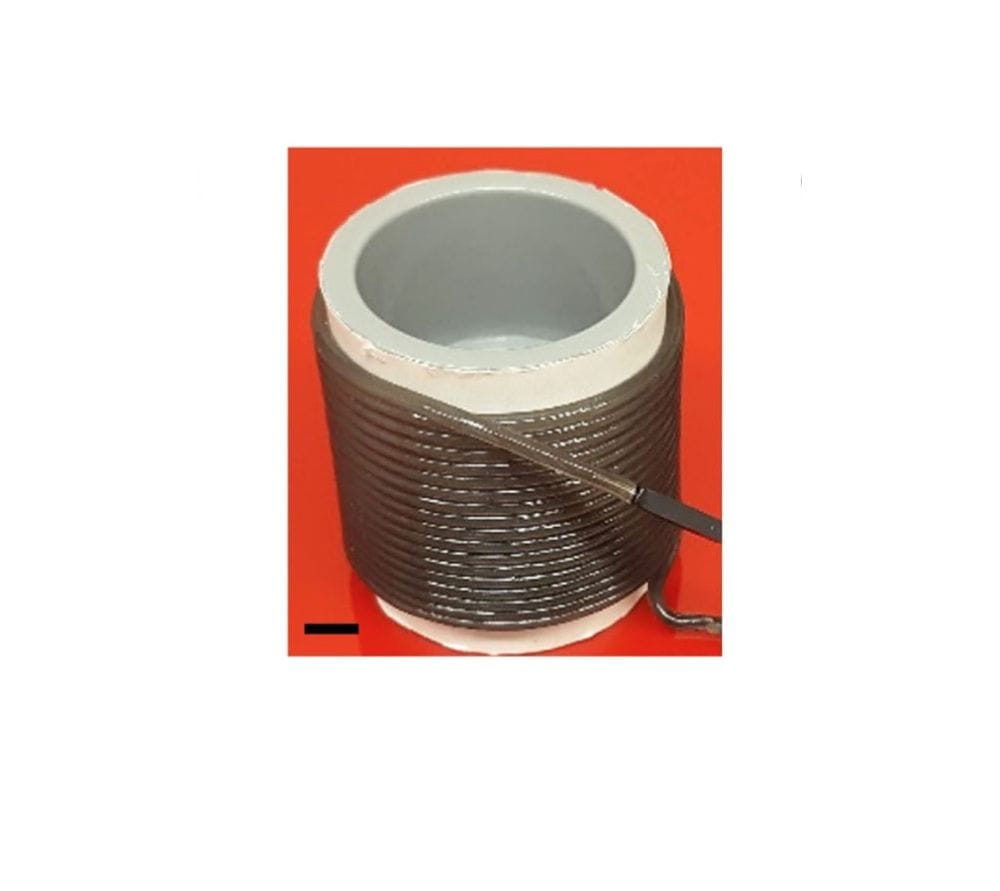![Printed stretchable wire [Source: Wiley]](https://fabbaloo.com/wp-content/uploads/2020/05/image-asset_img_5eb091761a354.jpg)
The concept of 3D printing electrical circuits has long fascinated those involved in 3D printing, and now there seems to be a way that this could be done in a very interesting manner using printed stretchable wires.
Researchers at the University of Alberta have been experimenting with liquid metal alloys, which are low melt temperature materials that often have far higher electrical transmission properties than other materials.
Liquid metal alloys are those made with metal elements with low melting points, such as mercury. However, mercury, while well known, is actually very toxic and thus liquid metal focus has shifted to other low-temperature metal elements such as gallium. In the University of Alberta experiment, the researchers used eutectic gallium indium, or “EGaIn”.
You might think that you’d simply heat and extrude this material, as is done with many other 3D printable materials. But that’s not really possible with EGaIn due to its incredibly low viscosity and tendency to form droplets due to its very high surface tension properties.
Printing Liquid Metal Alloys
![Tri-extruder concept for printing stretchable liquid metal alloy wires [Source: Wiley]](https://fabbaloo.com/wp-content/uploads/2020/05/image-asset_img_5eb091768d39b.jpg)
The researchers decided they needed to provide some type of coating that would allow the EGaIn material to properly form during extrusion. Their solution was to develop a prototype device that uses a coaxial extruder. We last wrote on coaxial extruders recently where someone was developing a coaxial approach for food 3D printing. That’s similar in concept to what’s going on here, but metal is involved.
The liquid metal alloy was extruded by a syringe-like mechanism with a diameter of 0.4mm, the same as the default size on most extrusion-based thermoplastic 3D printers today. However, this “needle” was surrounded by a tube of diameter 1.8mm, through which thermoplastic could be simultaneously extruded.
3D Printing SEBS
For the thermoplastic material, the researchers had to select a substance that provided the necessary container properties for EGaIn. Their choice was styrene-b-ethylene-co-butylene-b-styrene, or “SEBS”, a material I’m not familiar with and have not seen used on thermoplastic 3D printers. However, they say:
”As an insulating material, a thermoplastic material with high stretchability, flexibility, and mechanical stability was desired. Based on these properties, a thermoplastic elastomer, poly (styrene-b-ethylene-co-butylene-b-styrene) (SEBS), was chosen because of its superior mechanical properties suitable for stretchable electronics applications. In this work, a commercially available type of SEBS, Kraton G1657 was used. SEBS has a very high elongation at break (%750%), relatively high tensile strength (23.4 MPa), low hardness (47 Shore A), low 300% modulus (2.4 MPa), and high melt index (22 g/10 min at 230C, 5 kg).”
Their extruder had an interesting design, as it included not just two inputs, but three. The third entry port was intended for use as a second thermoplastic material, should a blend be required.
Pellet Input to 3D Printer
![Experimental 3D printing rig enabling production of stretchable wires [Source: Wiley]](https://fabbaloo.com/wp-content/uploads/2020/05/image-asset_img_5eb0917700c58.jpg)
This is likely because the input material was in pellet form. I’m not surprised because I cannot imagine finding a spool of 1.75mm SEBS filament for sale anywhere. The researchers had to develop the thermoplastic material for 3D printing themselves.
They did this by essentially bolting a filament extrusion system on top of their device by modifying a commercial Filastruder unit. This device is normally used for making one’s own filament, but in this case was used to crush the SEBS pellets and prep them for direct extrusion.
They did not build a new 3D printer, but instead modified an inexpensive desktop unit, a Geetech M201. I wonder if the manufacturers of these machines have any idea what is being done with their equipment?
![Cross section of printed stretchable wire, with SEBS on the outside and liquid metal alloy in the center [Source: Wiley]](https://fabbaloo.com/wp-content/uploads/2020/05/image-asset_img_5eb0917749d31.jpg)
When in operation, the contraption was able to successfully extrude stretchable wires. They were able to vary the diameter of the metal extrusion by changing the drawing speed. Note that their initial experiments were to simply extrude stretchable wires, not whole 3D objects. The drawing speed was controlled by a take-up spool holding the extruded stretchable wire.
3D Printing Conductive Wires
While this experiment demonstrated the feasibility of extruding stretchable highly conductive wires, there is now a possibility of leveraging this development in 3D printing. Imagine a 3D printer equipped with one or two “normal” thermoplastic extruders, and with a version of this stretchable wire extruder.
Such a device could possibly 3D print objects containing highly conductive components. This could enable not only electrical signals to traverse an object, but also electrical power. It may even be possible to 3D print small electromagnets using this technique.
Of course, this is only basic research and none of this has been commercialized. However, it does seem very interesting.
Via Wiley











A research thesis details the incredibly complex world of volumetric 3D printing. We review the highlights.